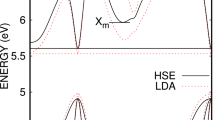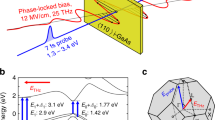Abstract
The kinetic effects:-Hall effect, magnetoresistance, and Nernst-Ettinghausen effect-are examined in n-type gallium arsenide having a free electron concentration at room temperature of less than 1015 cm−3.
The work was directed toward determining the dominating scattering mechanism in compensated material.
At low temperatures the scattering is predominately by impurity atoms and optical vibrations (optical phonons); at high temperatures, by acoustic phonons.
With simultaneous scattering by thermal vibrations and impurity ions, for temperatures T > 300 ° K, the second mechanism plays the basic role in the longitudinal Nernst-Ettinghausen effect.
Similar content being viewed by others
References
O. V. Emel'yanenko and D. N. Nasledov, ZhTF28, no. 6, 1177, 1958.
O. V. Emel'yanenko and D. N. Nasledov, FTT,1, no. 6, 985, 1959.
O. V. Emel'yanenko, T. S. Lagunova, and D. N. Nasledov, FTT,2, no. 2, 192, 1960.
D. N. Nasledov, J. Appl. Phys. Suppl. to vol. 32, no. 10, 2140, 1961 (Transactions of Conference on Semiconducting Compounds, Schenectady, New York, 1961).
A. F. Kravchenko, Izv. VUZ. Fizika, no. 3, 80, 1961.
R. Barrie, F. A. Cunnell, J. T. Edmond, and I. M. Ross, Physica,20, no. 11, 1087, 1954.
L. Pincherle and J. M. Radcliffe, Collection: Advances in Physics,5, no. 19, p. 271, 1956.
A. F. Kraychenko and H. Y. Fan, FTT,5, no. 2, 660, 1963.
J. W. Allen, Nature, 187, no. 4735, 403, 1960.
C. Hilsum and A. C. Rose-Innes, Semiconducting III-V Compounds, N. Y.-London, 1961.
C. H. Gooch, C. Hilsum, and B. R. Holeman, J. Appl. Phys., Suppl. to vol. 32, no. 10, 2069, 1961.
L. R. Weisberg, F. D. Rosi, and P. G. Herkart, collection: Properties of Elemental and Compound Semiconductors (Metallurgical Society Conference, Boston, 1959, V. 5), New York, p. 25, 1960.
J. M. Whelan and G. H. Wheatley, J. Phys. Chem. Solids,6, nos. 2–3, 169, 1958.
H. Brooks, Collection: Advances in Electronics and Electron Physics, vol. 7, New York, p. 85, 1955.
L. R. Weisberg, F. D. Rosi, and P. G. Herkart, collection: Properties of Elemental and Compound Semiconductors (Metallurgical Society Conference, Boston, 1959, vol. 5), New York, p. 85, 1960.
L. R. Weisberg, J. R. Woolston, and M. Glicksman, J. Appl. Phys., 29, no. 10, 1514, 1958.
E. M. Conwell and V. F. Weisskopf, Phys. Rev.,77, no. 3, 388, 1950.
K. B. Tolpygo, Trudy instituta fiziki AN USSR, 3, 52, 1952.
I. M. Tsidil'kovskii, Thermomagnetic Phenomena in Semiconductors [in Russian], Fizmatgiz, Moscow, 1960.
H. Ehrenreich, Phys. Rev., 120, no. 6, 1951, 1960.
Author information
Authors and Affiliations
Rights and permissions
About this article
Cite this article
Kravchenko, A.F. Galvanomagnetic and thermomagnetic effects in compensated gallium arsenide. Soviet Physics Journal 9, 45–48 (1966). https://doi.org/10.1007/BF00818737
Issue Date:
DOI: https://doi.org/10.1007/BF00818737




